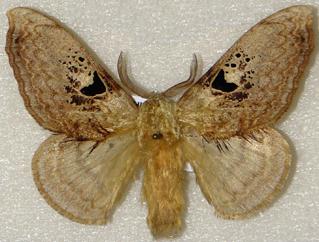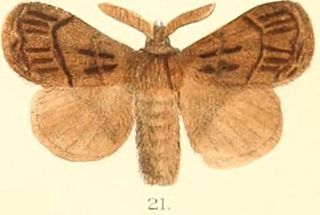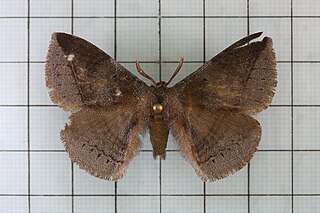Pyrosis is a genus of moths in the family Lasiocampidae. The genus was first described by Oberthür in 1880. The moths live in Asia.

Mirina is genus of moths in the Endromidae family. It was previously assigned to the family Bombycidae or its own family, the Mirinidae. The genus contains three described species.

Actias ningpoana, the Chinese moon moth, is a moth of the family Saturniidae. The species was first described by father-and-son entomologists Cajetan and Rudolf Felder in 1862. It is quite large, and has long, curved, hindwing tails. There are many congeners across Asia; the Luna moth of Eastern Canada and the United States is a close relative.
Collita is a genus of moths in the family Erebidae. The genus was described by Moore in 1878.

Dysauxes is a genus of moths in the family Erebidae. The genus was erected by Jacob Hübner in 1819.

Eilema is a genus of moths in the subfamily Arctiinae. The genus was erected by Jacob Hübner in 1819.

Manulea is a genus of moths in the family Erebidae erected by Hans Daniel Johan Wallengren in 1863. The type species is Lithosia gilveola Ochsenheimer, 1810.

Baodera is a monotypic moth genus in the family Lasiocampidae. The genus was erected by Zolotuhin in 1992. Its only species, Baodera khaisana, was described by Moore in 1879. It is found in India.
Cerberolebeda is a monotypic moth genus in the family Lasiocampidae described by Vadim V. Zolotuhin in 1995. Its single species, Cerberolebeda styx, described by the same author in the same year, is found in eastern India, Myanmar, northern Thailand, northern Laos, northern Vietnam and Hainan, China.

Gastropacha is a genus of moths in the family Lasiocampidae. It was first described by Ochsenheimer in 1810.
Gorgonella is a genus of moths in the family Lasiocampidae. The genus was erected by Vadim V. Zolotuhin in 2000.

Paralebeda is a genus of moths in the family Lasiocampidae. The genus was erected by Per Olof Christopher Aurivillius in 1894.

Mustilia is a genus of moths of the Endromidae family. The genus was previously placed in the subfamily Prismostictinae of the Bombycidae family.
Sesquiluna is a genus of moths of the Endromidae family.

Oberthueria is a genus of moths of the Endromidae family. The genus was previously placed in the subfamily Oberthueriinae of the Bombycidae family.

Ganisa is a genus of moths of the family Eupterotidae first described by Francis Walker in 1855.

Dysauxes famula is a moth of the family Erebidae. It was described by Christian Friedrich Freyer in 1836. It is found in the Transcaspian Oblast, the Caucasus, Iran, Asia Minor, Palestine, France, Switzerland, Italy, the Balkan Peninsula, Ukraine, as well as on Corsica, Sicily, Crete and Cyprus.
Dysauxes fraterna is a moth of the family Erebidae. It was described by Nikolay N. Ignatyev and Vadim V. Zolotuhin in 2006. It is found in Armenia.
Dysauxes kaschmiriensis is a moth of the family Erebidae. It was described by Rothschild in 1910. It is found in Kashmir, Pakistan and India.
Mustilizans dierli is a moth in the family Endromidae. It was described by Jeremy Daniel Holloway in 1987. It is found on Borneo and in Yunnan, China. It is found at elevations ranging from lowlands to 2,000 meters.










